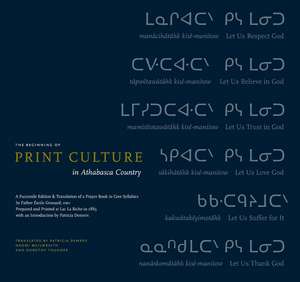Beginning of Print Culture in Athabasca Country: A Facsimile Edition & Translation of a Prayer Book in Cree Syllabics by Father …mile Grouard
Editat de Patricia DeMers, Naomi L. McIlwraith, Dorothy Thunder Cuvânt înainte de Arok Wolvengreyen Limba Engleză Hardback – 30 mai 2006
A signal event in the move from oral to print culture for the Cree was Father Grouard's prayer book, written in Syllabics and printed in 1883. More than a century later, Demers, McIlwraith, and Thunder reproduce the text, along with a direct English translation, a transliteration into the Standard Roman Orthography now in use as well as in nineteenth-century SRO. Demers offers an introduction to the work within its cultural framework; the translators together discuss Grouard’s use of Cree Syllabics, which illuminates the difficulties this missionary-pioneer faced in transferring the nuances of one language to another in which he was an ardent learner. Cree history scholars, linguists, and anyone interested in print history would be well served by adding this influential work to their library.
Preț: 531.47 lei
Preț vechi: 667.10 lei
-20% Nou
Puncte Express: 797
Preț estimativ în valută:
101.70€ • 106.45$ • 84.64£
101.70€ • 106.45$ • 84.64£
Carte indisponibilă temporar
Doresc să fiu notificat când acest titlu va fi disponibil:
Se trimite...
Preluare comenzi: 021 569.72.76
Specificații
ISBN-13: 9780888645159
ISBN-10: 0888645155
Pagini: 488
Ilustrații: Illustrations, map,
Dimensiuni: 276 x 254 x 36 mm
Greutate: 1.77 kg
Editura: University of Alberta Press
Colecția University of Alberta Press
Locul publicării:Canada
ISBN-10: 0888645155
Pagini: 488
Ilustrații: Illustrations, map,
Dimensiuni: 276 x 254 x 36 mm
Greutate: 1.77 kg
Editura: University of Alberta Press
Colecția University of Alberta Press
Locul publicării:Canada
Descriere
A signal event in the move from oral to print culture for the Cree was Father Grouard's prayer book, written in Syllabics and printed in 1883. More than a century later, Demers, McIlwraith, and Thunder reproduce the text, along with a direct English translation, a transliteration into the Standard Roman Orthography now in use as well as in nineteenth-century SRO. Demers offers an introduction to the work within its cultural framework; the translators together discuss Grouard’s use of Cree Syllabics, which illuminates the difficulties this missionary-pioneer faced in transferring the nuances of one language to another in which he was an ardent learner. Cree history scholars, linguists, and anyone interested in print history would be well served by adding this influential work to their library.
